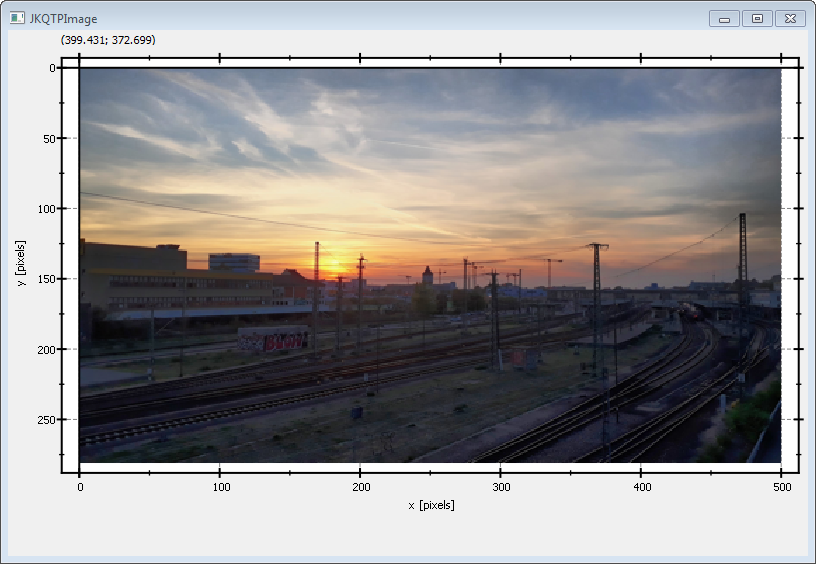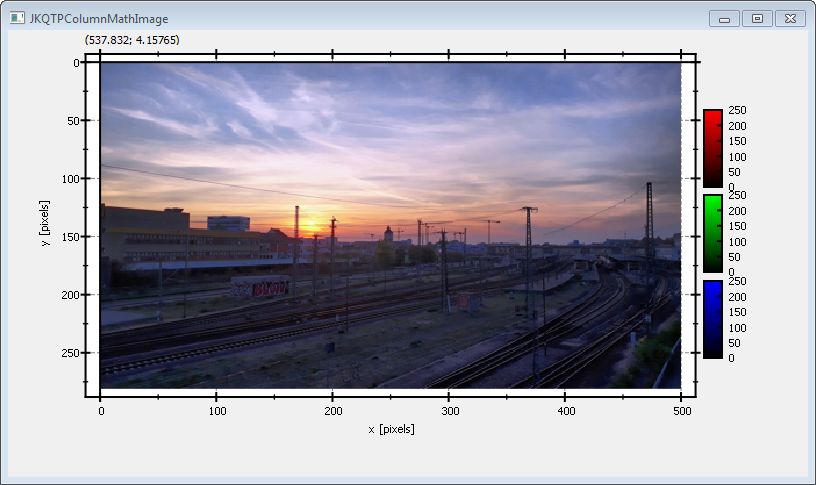mirror of
https://github.com/jkriege2/JKQtPlotter.git
synced 2025-01-24 14:42:30 +08:00
114 lines
4.9 KiB
Markdown
114 lines
4.9 KiB
Markdown
# Example (JKQTPlotter): Simple RGB image plot, showing a 3-channel OpenCV cv::Mat {#JKQTPlotterImagePlotRGBOpenCV}
|
|
This project (see `./examples/imageplot_opencv/`) simply creates a JKQTPlotter widget (as a new window) and shows an RGB image read from a BMP-file. The image is generated as an [OpenCV](https://opencv.org/) [`cv::Mat`](https://docs.opencv.org/4.0.0/d3/d63/classcv_1_1Mat.html) image and then copied into a single column of the internal datasdtore (JKQTPMathImage could be directly used without the internal datastore).
|
|
To copy the data a special OpenCV Interface function `JKQTPCopyCvMatToColumn()` is used, that copies the data from a (https://opencv.org/) [`cv::Mat`](https://docs.opencv.org/4.0.0/d3/d63/classcv_1_1Mat.html) directly into a column.
|
|
|
|
The function `JKQTPCopyCvMatToColumn()` is available from the (non-default) header-only extension from `jkqtplotter/jkqtpopencvinterface.h`. This header provides facilities to interface JKQTPlotter with OpenCV.
|
|
|
|
The source code of the main application is (see [`imageplot_opencv.cpp`](https://github.com/jkriege2/JKQtPlotter/tree/master/examples/imageplot_opencv/imageplot_opencv.cpp):
|
|
```.cpp
|
|
#include <QApplication>
|
|
#include <cmath>
|
|
#include "jkqtplotter/jkqtplotter.h"
|
|
#include "jkqtplotter/graphs/jkqtpimage.h"
|
|
#include "jkqtplotter/jkqtpopencvinterface.h"
|
|
#include <opencv2/core.hpp>
|
|
#include <opencv2/imgcodecs.hpp>
|
|
|
|
|
|
|
|
int main(int argc, char* argv[])
|
|
{
|
|
QApplication app(argc, argv);
|
|
|
|
JKQTPlotter plot;
|
|
|
|
|
|
// 1. create a plotter window and get a pointer to the internal datastore (for convenience)
|
|
plot.getPlotter()->setUseAntiAliasingForGraphs(true); // nicer (but slower) plotting
|
|
plot.getPlotter()->setUseAntiAliasingForSystem(true); // nicer (but slower) plotting
|
|
plot.getPlotter()->setUseAntiAliasingForText(true); // nicer (but slower) text rendering
|
|
JKQTPDatastore* ds=plot.getDatastore();
|
|
|
|
|
|
// 2. now we open a BMP-file and load it into an OpenCV cv::Mat
|
|
cv::Mat picture = cv::imread("example.bmp");
|
|
|
|
|
|
|
|
// 3. make data available to JKQTPlotter by adding it to the internal datastore.
|
|
// In this step the contents of each channel of the openCV cv::Mat is copied into a column
|
|
// of the datastore in row-major order
|
|
size_t cPictureR=JKQTPCopyCvMatToColumn(ds, picture, "R-channel", 2);
|
|
size_t cPictureG=JKQTPCopyCvMatToColumn(ds, picture, "G-channel", 1);
|
|
size_t cPictureB=JKQTPCopyCvMatToColumn(ds, picture, "B-channel", 0);
|
|
|
|
|
|
// 4. create a graph (JKQTPColumnRGBMathImage) with the columns created above as data
|
|
JKQTPColumnRGBMathImage* graph=new JKQTPColumnRGBMathImage(&plot);
|
|
graph->setTitle("");
|
|
// set size of the data (the datastore does not contain this info, as it only manages 1D columns of data and this is used to assume a row-major ordering
|
|
graph->setNx(picture.cols);
|
|
graph->setNy(picture.rows);
|
|
// where does the image start in the plot, given in plot-axis-coordinates (bottom-left corner)
|
|
graph->setX(0);
|
|
graph->setY(0);
|
|
// width and height of the image in plot-axis-coordinates
|
|
graph->setWidth(picture.cols);
|
|
graph->setHeight(picture.rows);
|
|
// image column with the data
|
|
graph->setImageRColumn(cPictureR);
|
|
graph->setImageGColumn(cPictureG);
|
|
graph->setImageBColumn(cPictureB);
|
|
// determine min/max of each channel manually
|
|
graph->setImageMinR(0);
|
|
graph->setImageMaxR(255);
|
|
graph->setImageMinG(0);
|
|
graph->setImageMaxG(255);
|
|
graph->setImageMinB(0);
|
|
graph->setImageMaxB(255);
|
|
|
|
|
|
|
|
// 5. add the graphs to the plot, so it is actually displayed
|
|
plot.addGraph(graph);
|
|
|
|
// 6. set axis labels
|
|
plot.getXAxis()->setAxisLabel("x [pixels]");
|
|
plot.getYAxis()->setAxisLabel("y [pixels]");
|
|
|
|
// 7. fix axis aspect ratio to width/height, so pixels are square
|
|
plot.getPlotter()->setMaintainAspectRatio(true);
|
|
plot.getPlotter()->setAspectRatio(double(picture.cols)/double(picture.rows));
|
|
|
|
// 8. autoscale the plot so the graph is contained
|
|
plot.zoomToFit();
|
|
|
|
// show plotter and make it a decent size
|
|
plot.show();
|
|
plot.resize(800,600);
|
|
plot.setWindowTitle("JKQTPColumnMathImage");
|
|
|
|
|
|
return app.exec();
|
|
}
|
|
|
|
```
|
|
The result looks like this:
|
|
|
|

|
|
|
|
The image is upside-down, because computer images use a coordinate system with 0 at the top-left (left-handed coordinate system) and the JKQTPlotter has its 0 at the bottom-left (right-handed coordinate system).
|
|
|
|
You can modify the program above to display the image in the correct orientation, by adding the line
|
|
```.cpp
|
|
// 5.1 invert y-axis, so image is oriented correctly
|
|
plot.getYAxis()->setInverted(true);
|
|
```
|
|
This will reorient the y-axis to point from top to bottom (for increasing positive coordinates):
|
|
|
|

|
|
|
|
|
|
|
|
|